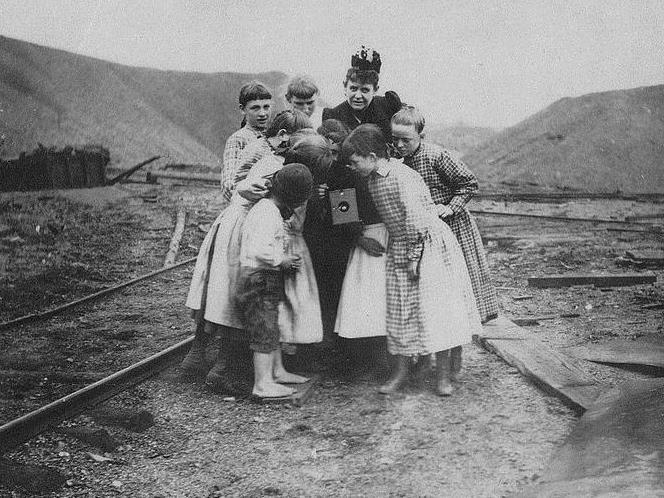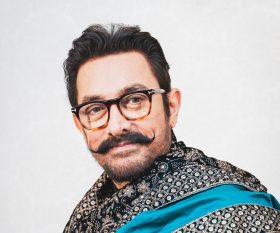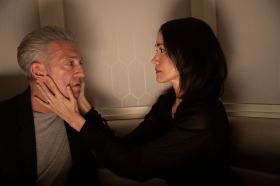Image: unknown origin, from Melbourne Women in Film Festival site.
It may have been modest in size but the inaugural Melbourne Women in Film Festival (MWFF) buzzed with energy and enthusiasm.
Created by a small and dedicated team, it ran for one evening and a full day on 3-4 March, just before International Women’s Day. Festival director Sian Mitchell, assistant festival director Kirsten Stevens, panel programmer Janice Lorek and contemporary shorts programmer are all film academics linked by Monash University.
At every point of its program, MWFF combined a humble nod to the past with a sharp eye on the present.
It opened boldly with a rare screening of silent Australian film The Cheaters (1929), produced by the entrepreneurial McDonagh sisters, Isabel (who also starred in the film), Paulette and Phyllis, and accompanied by a live score.
The morning retrospective on Patricia Edgar, founder of the Australian Children’s Television Foundation, sat alongside an afternoon panel featuring young, emerging women filmmakers on the obstacles they confront.
The organisers of MWFF inherited the aims and intentions of the original 1975 International Women’s Film Festival, which ran in Melbourne and Sydney to large, predominately female audiences, inspiring a generation of women filmmakers and empowering women activists. MWFF ran a keynote panel that included the original organisers of the 1975 Festival as well as a shorts program that screened rare films from the 1975 Festival alongside contemporary works.
One of the many events that marked the International Year of Women in 1975, the original Women’s Film Festival’s organising group included Jeni Thornley, Margot Oliver, Pat Longmore and Sue Johnston. Suzanne Spunner, who spoke at MWFF, was co-ordinator of the Festival in Melbourne, which had screenings at the Palais. The Festival included childcare services so all women could attend. The numbers were impressive.
‘I still recall the terror and excitement of standing on the stage at the Palais on Opening Night … looking out on to this pretty enormous audience and thinking “we’ve done this!” said Spunner.
The sense of achievement was profound.
‘You cannot underestimate what that did for our generation. That sense that you could do anything because you’d done something never went away’, Spunner asserted.
The original Women’s Film Festival was devoted to films made by and for women, at the time ignored by the industry. It was a time of extraordinary sexism.
‘Union regulations, not to mention the personal predilections of the projectionist, was that women were not allowed into the bio-box. We had naturally a large number of very strong, in every sense, women who wanted to carry cans of film all the way to the top of the theatre and were stopped. This was one of the many issues we had to fight’, said Spunner.
It is hard to imagine now, but the 1975 Festival was really the first demonstration that women audiences existed as a separate group. It was also the first time that the long struggle by individual women to participate in the screen sector became a public movement. They soon learned that the barriers are incredibly deep.
As a keynote event tied to the broader International Year of Women movement, the Festival was intended as a stand-alone. However, it played an important role in building the momentum of the Women’s Liberation Movement, and brought together women who later worked together within various art, theatre and film collectives as well as LIP, a feminist arts magazine founded in 1976 by Spunner.
Annette Blonski is a renowned screen practitioner and cultural commentator whose student film screened at the ’75 Festival and was herself a member of the Women’s Liberation Movement of the ‘70s. According to Blonski, it was a heady time in which profound and fundamental questions were being raised. Questions like what does it mean to live as a woman in the world? What alternative to patriarchal society exists and how to establish it? The way in which the collectives were organised was itself a political gesture.
‘We wanted to work in less formal structures. Inevitably they’re very difficult to sustain… after a while funding becomes an issue, people come and go, there are all sorts of ideological debates and disputes. It’s very difficult’, said Blonski.
While the decision to do away with traditional power structures may have undercut the Movement’s staying power, the act of questioning organisational structures and experimenting with alternatives was exhilarating.
‘The WLM at the time was all about discovering a whole range of things. It was discovering one’s power, how to act in the world, how to work collectively. It was about all of those things and it was bound to be a little chaotic. And in some ways that was probably not a bad thing!’
While the grassroots cooperatives and collectives may not have continued over time, quite a few of the women working within them went on to join existing organisations pursuing a reformist agenda from within. According to Blonski, these women went on to ‘get a toe into existing organisations, like the Australian Film Commission (now Screen Australia), eventually taking up very senior positions’.
Although some of the energy of the Women’s Liberation Movement was taken up by existing film organisations as women filled senior roles, women’s involvement in the sector has steadily dwindled to a point where it is alarmingly low.
For Blonski this has a lot to do with the winding up of the Women’s Film Fund at the AFC in the early ‘90s, followed by the slow loss of the whole program.
‘… we were ahead of the game back in the ‘80s. But there are serious consequences when you take your eye off the ball. The AFC’s Women’s Program used to do a lot of research, including at least two major surveys of the industry, so they were keeping track of what was happening with women’s involvement. That hasn’t happened since the Program was abandoned’.
‘Ending those programs had serious ramifications. If it isn’t a priority in the organisation, then it gives licence in effect to overlook it as an issue when it comes to decision making. It says “it’s ok” to the people who are making decisions about what projects go forward to just ignore those issues, to simply not even think about them’ said Blonski.
One initiative which attempts to rectify the situation is the Natalie Miller Fellowship, founded by Chrissie Thomson and which Blonski helped set up, that aims to bolster the number of women on the ‘demand’ side of the industry: the sales agents, distributors, exhibitors, broadcasters, investors. These are the powerbrokers who decide what stories get told and traditionally, they have been men, who, being men, have tended to back male stories.
Blonski explains how the initiative met with a positive response from within male-dominated organisations.
‘…a lot of the senior management in those organisations just hadn’t thought about the issue of women’s underrepresentation before and when it was pointed out to them some were very happy to come on board … I think it was an idea that was having its moment, that idea of the zeitgeist, you know, the timing is just perfect. I think this was one of those moments.’
Though data is not yet available, the success of the Fellowship is evident in the enthusiasm it has generated.
‘I can’t quote statistically how the numbers have changed at these organisations but certainly in terms of the enthusiasm of women to take up the programs, to recognise their own potential, to help other women … it’s been successful’.
Though it may be too early to tell, MWFF suggests it is another manifestation of this zeitgeist. Notwithstanding the important work of national film festivals and women’s organisations such as WIFT in programming women’s cinema over the years, MWFF combines a unique blend of historical excavation, critical appreciation of film practice and robust focus on practitioner issues that sets it apart from anything else that has come before.
While festival director Sian Mitchell, a lecturer in film studies at tertiary level, has plans for MWFF to expand, she intends the historical focus to be a constant.
‘Next year I want MWFF to be bigger and have more screening sessions. I’d like to put out a call for films by tertiary students as well as films by experimental and documentary filmmakers, and some features as well. But all the while keeping that historical element in there… We’ve got to have that ‘looking back’ emphasis’.
By putting women’s cinema back on the agenda, MWFF is an important tool for awareness raising and inspiring young women filmmakers.
‘Can you name a female Australian cinematographer? Not many. But they’re there. It’s about uncovering those roles. And hopefully inspiring emerging filmmakers or filmmaking students to say ‘ok, now I can pick up a camera” says Mitchell.
Although gender parity in the industry is still a far cry from reality, women filmmakers today have entered the industry with their basic rights intact. A common thread running through the commentary of the more experienced panellists at MWFF was the portentous current conservative climate and the threat it poses to hard-won gains.
‘Today’s women filmmakers do not know firsthand what’s been fought for and because of this they don’t know what there is to lose’, remarked Edgar, who rose to prominence in the 1970s, a time when women were expected to stay home as mothers and housewives. Edgar went on to smash any and every glass ceiling, performing executive-level roles throughout her decades-long career, steering boards, committees and university departments, establishing ground-breaking legislation for the television industry and completing pioneering research in the field of television and children.
Spunner expressed fear at how tenuous women’s rights are today.
‘It scares me how easily things can get wound back. We’d imagined that all of the things that we fought for would always go on progressing … that illusion has been dreadfully broken now. All those feminist things that were fought for must never, never, never be lost’.
Whilst initiatives like Screen Australia’s Gender Matters or the Natalie Miller Fellowship attempt to address gender imbalance in the industry, competition is fierce. A common thread linking the various panellists, of all ages, was the idea that a career in filmmaking requires fire-in-the-belly determination, and a willingness to pursue your vision often at your own expense.
‘Getting a filmmaking grant is very competitive’, says young writer/director Nora Niassari. ‘Filmmakers get rejected every day. I’m desensitised now, I don’t get my hopes up. You just have to keep trying and be persistent’.





